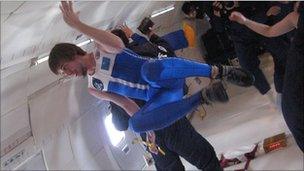Gravity suit mimics Earth's pull for astronauts
- Published

The suit is made of a fabric with carefully tailored stretchiness
A stretchy suit that mimics the effects of the Earth's gravity has been developed in the US to spare astronauts the ill effects of long missions of weightlessness.
Returning astronauts have lower bone density and muscle mass and can even suffer separation of their vertebrae.
The suit is made of a fabric with carefully tailored stretchiness.
It creates more of a pull at its wearer's feet than at the shoulders, replicating gravity's pull on Earth.
The suit is .
International space programmes have long been aware of the problems brought about by long stints in microgravity.
"We take for granted the fact that by sitting and walking around in the terrestrial environment, we're actually exercising our muscles and bones quite a bit," said Jim Locke, a flight surgeon for US space agency Nasa.
"When you're in space, that loading is removed, and your bones and muscles are not getting the forces they're needing to maintain themselves," he explained to 大象传媒 News.
The problem has been addressed by, for instance, the Russian "Pingvin" suit, a simple system comprising a waistband and sets of elasticated cords from the waist over the shoulders and down to the feet.
Dava Newman of the Man Vehicle Laboratory at the Massachusetts Institute of Technology (MIT) told 大象传媒 News that reports indicate that the Pingvin is uncomfortable.
"The cosmonauts were required to wear it on [former Russian space station] Mir -but they didn't necessarily like to wear it," she said.
One problem with the approach is that it only uses two levels of tension - between the shoulders and the waist, and between the waist and feet.
By contrast, gravity works incrementally on the body.
The shoulders, for example, support just the head; the waist supports the head and torso; the ankles support nearly the whole body.
To replicate this gradual force, Prof Newman and her colleague James Waldie designed a form-fitting suit, incorporating fibres that have a "tuneable" elasticity.
The suit is designed to "pull" downward on its wearer more nearer the feet - just as gravity does.
Optimising survival
"There are a lot of different theories of how to reduce the musculo-skeletal problem - this is a different take on it that looks pretty promising," Prof Newman said.
She added that the next step was to get the suits tested on an actual space mission.
Nasa's Dr Locke agreed. "There should be opportunities to get these things tested; it'll be interesting to see what the crew members think and if they see a benefit or find it too restrictive."
While the benefits that the suits may provide are not critical for current space missions, both the MIT group and Dr Locke are thinking longer-term.
"There are certainly significant problems for people that stay in space for six months or greater, but... we know in the future that with extended, long-duration stays in microgravity they'll become more important.
"We're always in the market for better countermeasures for astronauts to maintain their health and figure out ways to optimise human survival in space."